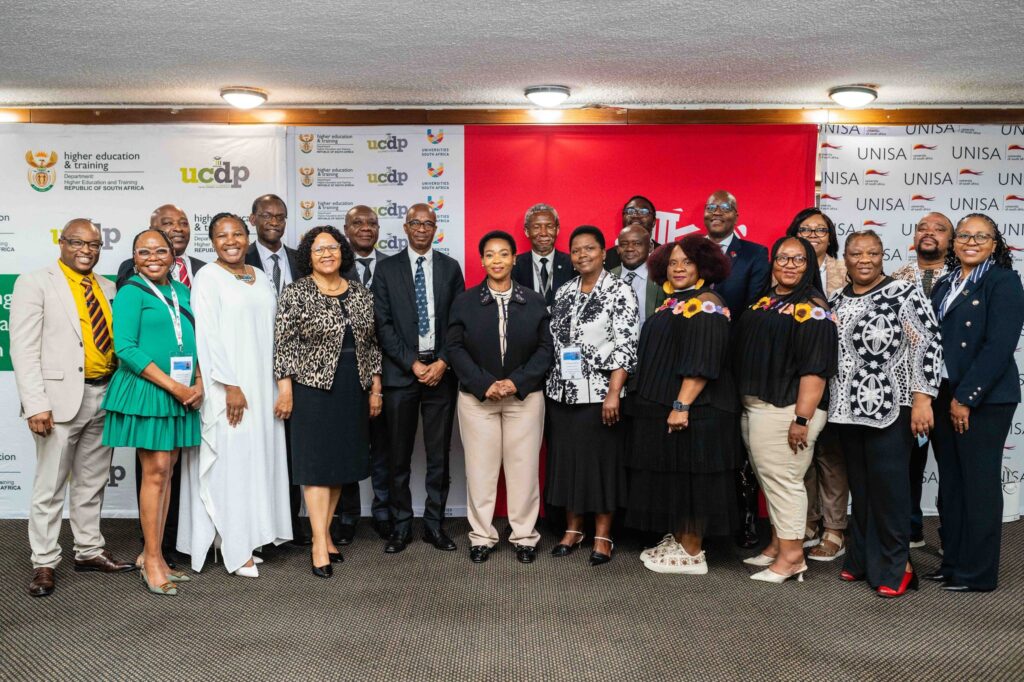Introduction: A Shift From Peripheral to Pivotal
In the heart of Pretoria, some 350 academics, practitioners, industry partners and students gathered at the University of South Africa’s (UNISA) Muckleneuk campus, under the theme “Entrepreneurship for Sustainability”, for the 7th EDHE Lekgotla (8–9 October 2025), alongside the 8th annual EDHE Studentpreneurs Indaba (6–7 October). Hosted by Universities South Africa (USAf) and in partnership with the Department of Higher Education and Training (DHET), this year’s event was more than a conference—it was a marker of transformation in the higher‐education ecosystem. edhe.co.za+1
Higher education in South Africa is under pressure. Graduate unemployment remains high. The need to not only educate students for existing job markets, but to prepare them to create new opportunities, has become urgent. The Lekgotla arrives at a moment when universities are being called to re‐imagine their roles—not only as knowledge factories, but as engines of sustainable economic, social and environmental value. edhe.co.za+1
Key Messages and Developments: Embedding Entrepreneurship
1. Institutionalising Entrepreneurship
Dr Nomusa Dube‐Ncube, Deputy Minister of Higher Education and Training, delivered a keynote affirming that entrepreneurship is no longer a fringe activity in universities but is being consciously embedded into institutional strategy. Universities are establishing Communities of Practice and Economic Activation Offices to connect academics, researchers, and students in ways that prioritize entrepreneurial thinking. Every lecture, every research project, every unit of academic work is viewed as an opportunity to seed entrepreneurial possibilities. futuresa.co.za+1
Leadership buy‐in is seen as critical. When university leadership recognises, sets policies, allocates resources, and rewards entrepreneurial teaching, research, and engagements, then entrepreneurship moves from optional to essential. UNISA’s role as co‐host this year underlines how distance/open learning institutions are also embracing this shift.
2. Student Entrepreneurs as Change Agents
The Studentpreneurs Indaba—running immediately before the Lekgotla—underscored the centrality of the student in this evolution. More than 250 students participated, bringing ideas and ventures in green and blue economies, rural and township entrepreneurship, digital innovation and sustainable models. These students are not just learning; they are already prototyping, experimenting, failing and scaling.
What is significant is that South African higher education is recognising that students are more than learners—they are potential job creators, innovators, and citizens required to address major challenges like climate change, inequality, and youth unemployment. Entrepreneurship is being framed as an integral skill for all students, regardless of discipline.
3. Sustainability as a Compass
The theme, Entrepreneurship for Sustainability, is not simply rhetorical. It encapsulates how universities are being asked to reframe what entrepreneurship should do—not only generate wealth, but promote social justice, environmental protection, and long-term economic resilience. Dialogue at the Lekgotla considered the green, blue, and circular economies; sustainable investment; and technology’s role (particularly AI) in accelerating research, reducing costs and societal impact.
This aligns with national and international imperatives. South Africa’s National Development Plan (2030), the UN’s Sustainable Development Goals, and continental frameworks such as Agenda 2063 demand that sustainable entrepreneurship be part of any serious national development strategy. Universities are being called to align their missions accordingly.
4. Research, IP and Partnerships
One of the more technical but critical discussions involved research commercialisation, intellectual property, AI / 4IR tools, and partnerships with industry. The goal is to reduce the barriers that have historically slowed the translation of university research into real‐world solutions and ventures: access to funding, infrastructure, expertise, and regulatory support.
Also underscored is the necessity of universities collaborating with external actors—private sector, government, venture capital, impact investors—not only for funding, but for co-designing curricula, incubators, mentorship, and commercialization pathways.
Challenges and Tensions: What Must Be Overcome
While the Lekgotla represents strong momentum, embedding entrepreneurship into the DNA of universities confronts many challenges:
-
Curricular rigidity and inertia: Many universities still operate under curricula that marginalise entrepreneurship—limited modules, optional courses and low integration into core programs. Research shows that even among top traditional universities in SA, entrepreneurship modules at undergraduate level are still sparse or post-first‐year only.
-
Resource constraints: Effective entrepreneurial ecosystems require funding, infrastructure (labs, makerspaces, incubators), mentorship, networks. Not all institutions have equal access. Post-school education funding models and academic staff workloads in SA make additional responsibilities burdensome.
-
Mindset shift: Academics, administrators, students and funders must buy into entrepreneurship not only as a goal but as part of their work. That means recognising failure, risk, uncertainty. It means valuing applied research and commercialization alongside purely theoretical work.
-
Measuring impact: How do you track whether entrepreneurship education is producing job creators, sustainable businesses, social value? Universities will need data systems, indicators, evaluation frameworks.
What Success Looks Like: Envisioning DNA-Level Entrepreneurship
To move from ambition to transformation, here are areas that must take root deeply—and swiftly:
-
Mandatory entrepreneurship exposure for all students, regardless of major—through required modules, cross-disciplinary projects, or experiential learning.
-
Institutional structures such as Economic Activation Offices, Centres for Entrepreneurial Learning & Research, with stable funding, visible leadership, accountability and reward systems.
-
Partnerships with industry, investors, government and civil society to provide resources, mentorship, market access, and co-creation.
-
Integration of sustainability (environmental, social, economic) into the missions of student ventures, research agendas and university policy.
-
Use of technology and AI to amplify ideation, reduce cost and risks, speed up research translation, simulation – for example, AI tools for research, idea validation, prototyping.
-
Policy and regulatory alignment, including IP laws, university innovation policy, funding models that reward commercialisation and social impact.
-
Monitoring and evaluation: data on graduate entrepreneurs, survival rates of student ventures, measurable social/environmental outcomes.
Implications: Why This Matters Now
-
Youth unemployment crisis: South Africa has one of the world’s highest youth unemployment rates—46.1% for young people in early 2025. Conventional job creation alone cannot absorb the number or meet the pace. Entrepreneurship must help fill the gap.
-
Global competitiveness & knowledge economy: The world is increasingly driven by innovation. Countries with strong entrepreneurial universities tend to generate more high-impact research, startups, patents, and attract investment. SA’s ability to compete in 4IR, green economy, climate tech, digital innovation depends on embedding entrepreneurship deeply.
-
Social equity & inclusion: Township, rural, historically disadvantaged communities have not benefitted equally from traditional employment sectors. Entrepreneurship offers pathways for agency, local innovation, context-sensitive solutions.
-
Sustainability & environmental resilience: As climate risk grows, as global pressure mounts to shift toward cleaner economies, universities have a duty and opportunity to be laboratories of sustainable innovation.
Looking Forward: From Lekgotla to Lasting Change
If the Lekgotla is to be more than inspiration and rhetoric, the following must happen:
-
Implementation roadmaps at each university, with targets, budgeting, staff, monitoring, over multi-year horizons.
-
National oversight and support: DHET and USAf must support policy frameworks, funding windows, and incentives for universities that lead in entrepreneurial integration.
-
Sharing best practices: Learning from institutions already doing well, locally and abroad; the Communities of Practice structure in EDHE seems well placed for this.
-
Inclusive and equitable access: Ensure entrepreneurship is accessible to all students—not only those already privileged or in urban areas.
-
Risk tolerance and celebrate failure: Creating culture where student experiments, prototypes, even failed ventures are valued as learning.
 Conclusion: Entrepreneurship as University DNA
Conclusion: Entrepreneurship as University DNA
The 2025 EDHE Lekgotla, alongside the Studentpreneurs Indaba, was a touchstone event. The deeply felt messages: universities in South Africa are changing—leadership is taking entrepreneurship seriously. But embedding entrepreneurship into institutional DNA means reshaping curricula, culture, incentives, and outlook. It demands more than conferences—it demands sustained institutional reform, alignment of resources, and courageous leadership.
In the years ahead, South Africa’s hope pivots on whether its universities equip graduates not only to enter job markets but to define them. Whether students can see themselves not only as seekers of employment but creators of value. If the momentum from the EDHE Lekgotla is carried through, then maybe we can say entrepreneurship has truly become part of our universities’ DNA.



































